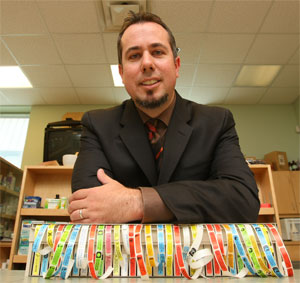 |
| Dr. Neil McKinnon: "SafetyNET is like a goalie, the last line of defence to prevent the puck from getting in the net." (Nick Pearce Photo) |
Every day, pharmacists sidestep potential mix-ups while theyāre filling prescriptionsāperhaps the doctorās scrawl is hard to decipher or sometimes the drug bottle is mistaken for another that looks awfully similar. In most cases, errors are caught and corrected before that pill bottle ever reaches the customer.
But now, for the first time, those near-misses are being reported to the Institute for Safe Medication Practices (ISMP) Canada in a unique pilot project called SafetyNET. In the first eight months of a year-long study, 813 near-misses were counted among 13 participating pharmacies in Nova Scotia. The pharmacies range from small rural independents, to grocery store pharmacies and large chains.
āItās a very sensitive topic because no one wants to make a mistakeāespecially in these types of cases, because a mistake can affect someoneās health,ā says Neil MacKinnon, SafetyNETās co-principal investigator and associate professor with »ĘÉ«Ö±²„ās College of Pharmacy. He also notes that in the health care systemās āculture of blame,ā reporting medication errors could get you fired or reprimanded.
There is currently no mandatory system for reporting medication errors. And yet, the potential for problems is huge: Dr. MacKinnon says 453 million prescriptions were dispensed in Canada last year. Itās estimated that one in 11 emergency room visits by seniors are due to medication errors.
But without reporting, it is difficult, if not impossible, to make the system better: to catch that error that slips through checks and double-checks and harms someoneās health. As well as reporting near-misses, participating pharmacies are holding quarterly staff meetings to discuss errors and make improvements.
āPharmacies are busy places and pharmacists are always being interruptedāyouāre doing one thing and switching to something else, for example, answering the phone or talking to a customer,ā says Sandeep Sodhi, pharmacist and co-owner of Village Family Pharmacy in Bible Hill, N.S. āSo thereās the potential to make errors. The good thing about SafetyNET is that it helps us identify where the problems are occurring and to do so something about it.ā
 |
The most common errors caught by the SafetyNET study have involved dosage problems. Other problems have included:
- illegible handwriting on the prescription
- problems with interpreting the prescription
- incorrect drug strength or concentration
- incorrect duration of treatment
- prescription of meds that are inappropriate for a patient because of other meds
- mix-ups between drugs names that sound similar when prescriptions are taken over the phone
- errors made during the filling of the prescription, such as dispensing too few pills or mixing up the bottles of two prescriptions
āBottles of drugs look similar and a lot of drug names are very close,ā explains Dr. MacKinnon. Losec, for example, is a medication used to slow or prevent the production of acid within the stomach and is prescribed for the proper healing of stomach and intestinal ulcers. It sounds a lot like Lasix, a diuretic used to control high blood pressure.
Possible solutions include minimizing disruptions for the pharmacist, working to instigate a system of electronic prescriptions and improving counseling at the point in which the patient receives their medication.
And now the study is being expanded. A $115,000 grant from the Social Sciences and Humanities Research Council (SSHRC) will allow researchers to expand SafetyNET to involve 70 pharmacies across the province in the fall.
āSafetyNET is like a goalie, the last line of defence to prevent the puck from getting in the net,ā says Dr. MacKinnon. āWe want that goalie to have the best training, the best equipment available to do their job.ā
